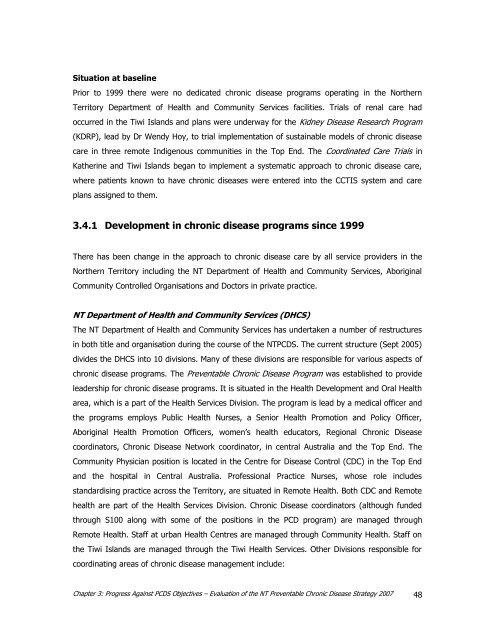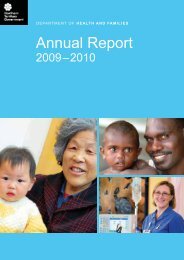PCD Strategy Evaluation 2007.pdf - NT Health Digital Library ...
PCD Strategy Evaluation 2007.pdf - NT Health Digital Library ...
PCD Strategy Evaluation 2007.pdf - NT Health Digital Library ...
You also want an ePaper? Increase the reach of your titles
YUMPU automatically turns print PDFs into web optimized ePapers that Google loves.
Situation at baselinePrior to 1999 there were no dedicated chronic disease programs operating in the NorthernTerritory Department of <strong>Health</strong> and Community Services facilities. Trials of renal care hadoccurred in the Tiwi Islands and plans were underway for the Kidney Disease Research Program(KDRP), lead by Dr Wendy Hoy, to trial implementation of sustainable models of chronic diseasecare in three remote Indigenous communities in the Top End. The Coordinated Care Trials inKatherine and Tiwi Islands began to implement a systematic approach to chronic disease care,where patients known to have chronic diseases were entered into the CCTIS system and careplans assigned to them.3.4.1 Development in chronic disease programs since 1999There has been change in the approach to chronic disease care by all service providers in theNorthern Territory including the <strong>NT</strong> Department of <strong>Health</strong> and Community Services, AboriginalCommunity Controlled Organisations and Doctors in private practice.<strong>NT</strong> Department of <strong>Health</strong> and Community Services (DHCS)The <strong>NT</strong> Department of <strong>Health</strong> and Community Services has undertaken a number of restructuresin both title and organisation during the course of the <strong>NT</strong><strong>PCD</strong>S. The current structure (Sept 2005)divides the DHCS into 10 divisions. Many of these divisions are responsible for various aspects ofchronic disease programs. The Preventable Chronic Disease Program was established to provideleadership for chronic disease programs. It is situated in the <strong>Health</strong> Development and Oral <strong>Health</strong>area, which is a part of the <strong>Health</strong> Services Division. The program is lead by a medical officer andthe programs employs Public <strong>Health</strong> Nurses, a Senior <strong>Health</strong> Promotion and Policy Officer,Aboriginal <strong>Health</strong> Promotion Officers, women‟s health educators, Regional Chronic Diseasecoordinators, Chronic Disease Network coordinator, in central Australia and the Top End. TheCommunity Physician position is located in the Centre for Disease Control (CDC) in the Top Endand the hospital in Central Australia. Professional Practice Nurses, whose role includesstandardising practice across the Territory, are situated in Remote <strong>Health</strong>. Both CDC and Remotehealth are part of the <strong>Health</strong> Services Division. Chronic Disease coordinators (although fundedthrough S100 along with some of the positions in the <strong>PCD</strong> program) are managed throughRemote <strong>Health</strong>. Staff at urban <strong>Health</strong> Centres are managed through Community <strong>Health</strong>. Staff onthe Tiwi Islands are managed through the Tiwi <strong>Health</strong> Services. Other Divisions responsible forcoordinating areas of chronic disease management include:Chapter 3: Progress Against <strong>PCD</strong>S Objectives – <strong>Evaluation</strong> of the <strong>NT</strong> Preventable Chronic Disease <strong>Strategy</strong> 2007 48
















